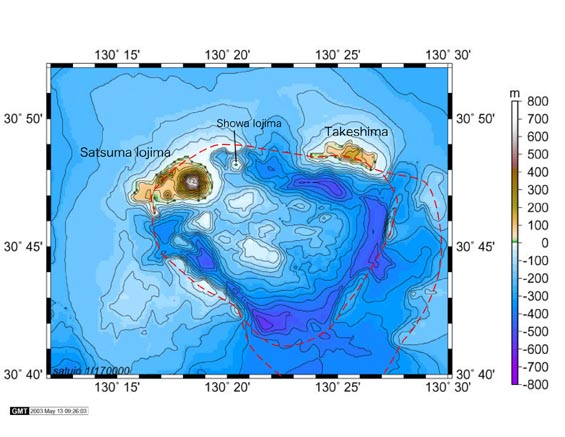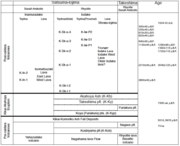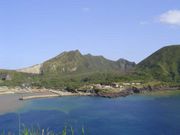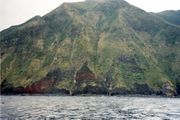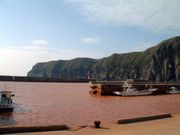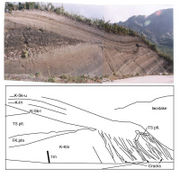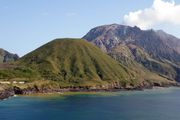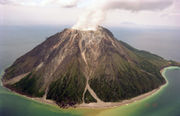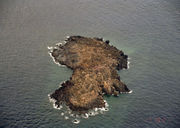History of the volcano
火山研究解説集:薩摩硫黄島 (産総研・地質調査総合センター作成)
| Contents: Satsuma-iojima |
|---|
- Iojima seen from Nagahama Lava Flow
Introduction
Iojima, Takeshima, and surrounding reefs are situated about 50 km to the south of Satsuma Peninsula, Kagoshima Prefecture, Kyushu, and consist of volcanic ejecta related to submarine Kikai Caldera. Iodake in Iojima has been active with fumarolic activities and small-scale eruptions of ash to this day.
Summary of geology and history of eruptions of Satsuma-iojima Volcano along with activities related to Kikai Caldera are described below.
Kikai Caldera and accompanying ejecta
- Topographic map of the Kikai Caldera
Kikai Caldera, 20 km EW and 17 km NS is a large submarine caldera. It is shown by red broken line in the attached figure. Many post-caldera volcanoes are distributed within the submarine caldera.
At least four large eruptions accompanied with pyroclastic flows are recognized in the past. Among the large pyroclastic flow deposits, Koabiyama and Takeshima Pyroclastic Flow Deposits are identified in Iojima. Takeshima Pyroclastic Flow Deposit is originated from the latest large-scale eruption of Kikai Caldera (Kikai-Akahoya eruption) estimated to have occurred about 7,300 years before the present which reached southern tip of Kyushu (Koya Pyroclastic Flow) and caused severe damage to Jomon culture of that time. Ash fall (Akahoya Ash Fall) at the same time covered extensive areas from western Japan to Kanto area and it has been utilized as a very important time marker bed for archeology and paleo-environmental studies.
Satsuma-iojima Volcano
- Geologic map of the Satsuma-iojima (November 2006 edition)
Iojima is a volcanic island situated at NW edge of Kikai Caldera and consists of pre-caldera volcanic deposits preceding Kikai-Akahoya eruptions and two post-caldera volcanoes of Iodake and Inamuradake.
Pre-caldera volcano
Depositional units forming pre-caldera volcanoes in Iojima are Yahazudake Volcano, Nagahama Lava Flow, Koabiyama Pyroclastic Flow, and Kikai-Komoriko Ash Fall Deposits. Yahazudake Volcano is a small stratovolcano consisting of basalt-andesite distributed in the northern part of Iojima. Its southern half is cut and lost by Kikai Caldera wall, but lava flow topography can be partially recognized in the northern slope. On the northern sea cliff are well exposed stack of basaltic lava flows and scoria deposits of Yahazudake. On the west of Iojima are high cliffs of dacitic Nagahama Lava Flows.
Koabiyama Pyroclastic Flow Deposits, erupted at the time of caldera formation, cover all the above. At the base of Koabiyama Pyroclastic Flow Deposits is fine-grained (less than 2 cm diameter) pumice fall deposit which is overlain by the main body of pyroclastic flow. Most pyroclastic flow is strongly welded and hard. Where filling valleys it thickens and the lenses of welded parts reach 20-30 m thick.
At Heikenojo, the NE end of Satsuma-iojima, Kikai-Komoriko Tephra Fall Deposits are exposed overlying Koabiyama Pyroclastic Flow Deposits. Kikai-Komoriko Tephra Fall is understood to have originated from andesitic volcano related to Kikai Caldera. It is intercalated with Satsuma Volcanic Ash Bed originated from Sakurajima about 13,000 years ago.
Takeshima Pyroclastic Flow Deposits
About 7,300 years ago, latest large-scale pyroclastic flow eruption (Kikai-Akahoya eruption) occurred at Kikai Caldera. The ejecta of this eruption are classified into the following in the ascending order: Koya (Funakura) Pumice Fall, Funakura Pyroclastic Flow, and Takeshima Pyroclastic Flow Deposits (Ono et al., 1982).In Iojima, Koya (Funakura) Pumice Fall and Takeshima Pyroclastic Flow Depoits are distributed.
Takeshima Pyroclastic Flow is a deposit containing white pumices and distributed even in southern Kyushu beyond the intervening sea. It is called Koya Pyroclastic Flow Deposit there. In Takeshima, eastern plateau is mostly overlain up to 20 to 30 m thick of this. On the other hand in Iojima, it is thinner and distributed in Heikenojo, in an area near Sakamoto, and over Nagahama Lava Flow. Takeshima Pyroclastic Flow Deposit in Iojima is rich in accidental lithic fragments with less pumice indicating it is deposited closer to the crater.
Post-caldera volcano
Post-caldera volcanic deposits in Iojima are represented as rhyolitic Iodake and basaltic Inamuradake. After the Kikai-Akahoya eruption, rhyolitic magma resumed activities near present day Iodake about 5,200 years ago. Inamuradake erupted about 3,900 years ago. Volcanic ash and scoria ejected by those activities have deposited on Heikenojo area, Yahazudake, and Nagahama Lava Flow. Different pyroclatic fall deposits are identified with the development of intervening humus-rich soil, and according to Kawanabe and Saito (2002) eight layers of tephra fall deposits have been discriminated at the mountain foot area.
Inamuradake
Inamuradake is a small basaltic composite volcano located in the east of Satsuma-iojima settlement. It began eruptive activity about 3,900 years ago and ceased to erupt before 2,200 years ago. More than four layers of scoria fall deposits are discriminated. Several lava flows are exposed along southern coast of Iojima from Higashi Hot Spring to Nagahama. Most ejecta are products of on-land eruptions, but a surge deposit from phreatomagmatic explosion is identified within the upper member of Inamuradake Pyroclastic Fall Deposit. It is distributed over Nagahama Lava Flow near Nagahama settlement.
Iodake
Iodake is a volcano consisting of thick rhyolitic to dacitic lava flows and lava domes along with rolling (essential) breccia from the collapse of the mountain body at the time of eruption. Volcanic activity commenced about 5,200 years ago but the current surface seems to have formed after the completion of Inamuradake formation about 2,200 years ago, and no early ejecta are known exposed. Rhyolitic lava dome of the summit was formed before 1,100 years ago. After that, explosive eruptions continued up until 500 to 600 years ago. In the eruptions of 1,200 yBP and 500-600 yBP, pyroclastic flows came down to the mountain foot in the west of the volcano.
Since about 1996, the summit crater often repeats small-scale eruptions ejecting altered ash.
Post caldera volcanoes in the vicinity
Post-caldera volcanoes are distributed in the sea around Iojima. Most of them are found in the sea, but rhyolite lava is exposed at a shallow reef to the south of Iojima. In September 1934, a rhyolite island, Showa-iojima, was born by a submarine eruption about 2 km east of Iojima.
References
Kawanabe, Y. and Saito, G. (2002) Volcanic activity of the Satsuma-Iwojima area during the past 6500 years. Earth Planets and Space,vol.54,p.295-301.
Ono, K., Soya, T. and Hosono, T. (1982) Geology of the Satsuma-Io-Jima District. Quadrangle Series, Scale 1:50,000, Geol. Surv. Japan, 80p. (in Japanese with English Abstract, 5 p.).
(Yoshihisa KAWANABE)

